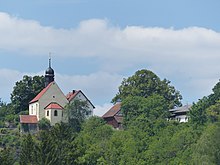Klausstein
|
Klausstein
Ahorntal municipality
Coordinates: 49 ° 49 ′ 38 ″ N , 11 ° 22 ′ 31 ″ E
|
|
|---|---|
| Height : | 439 (426-444) m above sea level NHN |
| Residents : | 7 (1987) |
| Postal code : | 95491 |
| Area code : | 09202 |
|
The Ahorntaler district of Klausstein
|
|
Klausstein is a Franconian wasteland that belongs to the municipality of Ahorntal .
geography
The wasteland in the north-eastern part of Franconian Switzerland is one of 26 officially named parts of the municipality of Ahorntal in the south-eastern part of Upper Franconia . The at an altitude of 439 m above sea level. NHN located place is about two kilometers from the east-northeast lying center of Kirchahorn , in which the Ahorntaler municipal administration has its seat.
history
Until the beginning of the 19th century, Klausstein had been in the village markings of Kirchahorn, a territory that was under the sovereignty of imperial nobles. This had in the Frankish knights circle belonging Ritter Canton Gebürg organized, which is decisive for the country's sovereignty village and township government was supported by the Counts of Schönborn exercised. The high jurisdiction was to the Bishopric of Bamberg belonging Office Waischenfeld than cents Office to. When the territories of the imperial knighthood in Franconian Switzerland were mediated as a result of the imperial deputation main conclusion , Klausstein was annexed by the electorate Palatinate-Baiern on November 1, 1805, in violation of the imperial constitution . The former wasteland thus became part of the New Bavarian territories that were taken over by the "Napoleonic land consolidation" , which was only subsequently legalized in July 1806 with the Rhine Confederation Act.
As a result of the administrative reforms in the Kingdom of Bavaria at the beginning of the 19th century, Klausstein became part of the rural community of Kirchahorn with the second municipal edict in 1818 , to which the towns of Dentlein , Neumühle , Rabenstein , Schweinsmühle , Weiher , Windmühle , Wünschendorf and Zauppenberg also belonged. In the course of the municipal territorial reform in Bavaria in the 1970s, on April 1, 1971 the village of Christanz with the hamlet of Brünnberg was incorporated into the municipality of Kirchahorn. Together with the thus enlarged municipality of Kirchahorn, Klausstein became part of the newly formed municipality of Ahorntal on January 1, 1972. In 1987 Klausstein had seven residents.
traffic
A communal connecting road branching off the district road BT 34 to the north-east of the desert runs directly past the northern edge of the village and continues to Eichenbirkig or branching south to Oberailsfeld . Klausstein is not served by public transport , the closest bus stop is at Schweinsmühle on State Road St 2185 . The quickest train stations are in Creußen , Schnabelwaid and Pegnitz . The next long-distance train station is the main train station in Bayreuth .
Attractions

In and around Klausstein there are two listed objects, namely a wayside shrine and the Klausstein chapel .
literature
- Herbert Popp , Klaus Bitzer, Halk Thomas Porada: Franconian Switzerland . Ed .: Sebastian Lentz , Bernhard Müller (= Landscapes in Germany ). Böhlau Verlag, Vienna, Cologne, Weimar 2019, ISBN 978-3-412-51535-5 .
- Gertrud Diepolder : Bavarian History Atlas . Ed .: Max Spindler . Bayerischer Schulbuch Verlag, Munich 1969, ISBN 3-7627-0723-5 .
- Federal Statistical Office (Hrsg.): Historical municipality register for the Federal Republic of Germany. Name, border and key number changes in municipalities, counties and administrative districts from May 27, 1970 to December 31, 1982 . W. Kohlhammer, Stuttgart / Mainz 1983, ISBN 3-17-003263-1 .
Web links
- Klausstein in the Topographia Franconiae of the University of Würzburg , accessed on July 5, 2020.
- Klausstein in the Bavarian Authority Guide , accessed on July 5, 2020
- Klausstein in the BayernAtlas , accessed on July 5, 2020
- Klausstein on a historical map , accessed on July 5, 2020
Individual evidence
- ↑ a b Bavarian State Office for Statistics and Data Processing (Ed.): Official local directory for Bavaria, territorial status: May 25, 1987 . Issue 450 of the articles on Bavaria's statistics. Munich November 1991, DNB 94240937X , p. 292 ( digitized version ). Retrieved July 5, 2020
- ^ Klausstein in the location database of the Bavarian State Library Online . Bayerische Staatsbibliothek, accessed on July 5, 2020.
- ↑ Geographical location of Klausstein in the BayernAtlas , accessed on July 5, 2020
- ↑ Franconian Switzerland . In: Landscapes in Germany . S. 66 .
- ^ A b Johann Kaspar Bundschuh : Kirchahorn . In: Geographical Statistical-Topographical Lexicon of Franconia . tape 3 : I-Ne . Verlag der Stettinische Buchhandlung, Ulm 1801, DNB 790364301 , OCLC 833753092 , Sp. 99 ( digitized version ).
- ↑ Gertrud Diepolder : Bavarian History Atlas . Ed .: Max Spindler . Bayerischer Schulbuch Verlag, Munich 1969, ISBN 3-7627-0723-5 , p. 31 .
- ↑ Gertrud Diepolder : Bavarian History Atlas . Ed .: Max Spindler . Bayerischer Schulbuch Verlag, Munich 1969, ISBN 3-7627-0723-5 , p. 97-103 .
- ↑ Gertrud Diepolder : Bavarian History Atlas . Ed .: Max Spindler . Bayerischer Schulbuch Verlag, Munich 1969, ISBN 3-7627-0723-5 , p. 35 .
- ↑ Gertrud Diepolder : Bavarian History Atlas . Ed .: Max Spindler . Bayerischer Schulbuch Verlag, Munich 1969, ISBN 3-7627-0723-5 , p. 106-107 .
- ^ Federal Statistical Office (ed.): Historical municipality directory for the Federal Republic of Germany. Name, border and key number changes in municipalities, counties and administrative districts from May 27, 1970 to December 31, 1982 . W. Kohlhammer, Stuttgart / Mainz 1983, ISBN 3-17-003263-1 , p. 697 .


